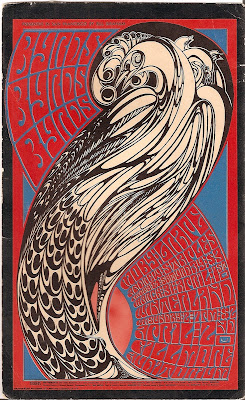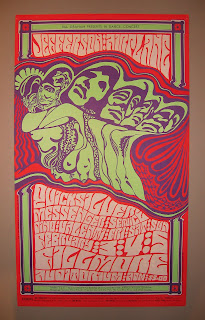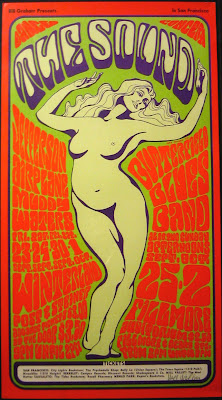Putting the psychedelic back into this blog.
The Fillmore Auditorium & Fillmore West:
San Francisco’s Fillmore West had its beginnings in 1912 as the Majestic Hall, an Italianate-style dance hall at the southwest corner of Fillmore and Geary. Wednesday night socials and masquerade balls were the usual fare, which were held on the second and third floors. In the Thirties the Fillmore was primarily a dance hall (with names such as The Get Acquainted Society and the Ambassador Dance Hall); in the Forties it was a roller rink and in the Fifties Charles Sullivan booked some of the biggest names in black music such as James Brown, Bobby “Blue” Bland, and Ike & Tina Turner.
In the early 1960s transplanted New Yorker Bill Graham was invited to attend a free concert in Golden Gate Park where he met the radical theater group The San Francisco Mime Troupe. When Mime Troupe leader Ronny Davis was arrested on obscenity charges Graham organized a benefit concert to cover the legal fees. The concert was a success, and Graham saw a business opportunity: he approached Charles Sullivan who still owned the master lease on the Fillmore Auditorium.
The Second Mime Troupe appeals concert was held at the Fillmore on December 10, 1965 using Sullivan's dance hall permit for the show. Graham later secured a contract from Sullivan for the open dates at the Fillmore Auditorium in 1966.
Due to a deteriorating neighborhood and the modest capacity of the hall Graham moved the venue in July 1968 from the original building to the Carousel Ballroom at 10 South Van Ness Avenue and renamed it the Fillmore West in contrast with his Fillmore East auditorium in the East Village in New York City.
The original Fillmore location became a venue called The Elite Club, and punk promoter Paul Rat booked punk rock shows at the venue for several years. It was later reopened under Graham's management in the mid-1980s but it was damaged and closed by the Loma Prieta earthquake of October 1989. Graham died in a helicopter crash in 1991, but according to his wishes the original Fillmore was re-opened on April 27, 1994, and has once again become a San Francisco hot spot. Live Nation has recently begun a campaign to expand the Fillmore "brand" by changing the names of a number of established clubs it owns around the U.S.
The Avalon Ballroom:
The building that housed the Avalon Ballroom was built in 1911 and was originally called the Colin Traver Academy of Dance. The Avalon as we knew it was founded in 1966 by Robert E. Cohen and Chet Helms along with Family Dog Productions, which had offices on Van Ness. The Avalon occupied the two top floors of the multi-story building: an L-shaped, second-floor balcony surrounded the first-floor along the south and western walls, and the dance area was in front of the elevated stage in the northeast corner where musicians performed. The Avalon was not as large as the Winterland or The Fillmore, but it still had a capacity of up to 500.
 |
| Family Dog |
Bands were frequently booked to perform at the Avalon on Thursday, Friday and Saturday. In the 1960s two bands typically performed two sets each beginning at about nine o'clock. The Grateful Dead recorded their two live albums -Vintage Dead and Historic Dead- here in the autumn of 1966.
The Avalon lost its lease in November 1968 and the space was converted to a movie theater. In 2003 Steve Shirley (aka Morning Spring Rain) of the Hog Farm commune restored and re-opened the Avalon Ballroom as part of the Regency Center, a music hall and special-events space.
References:
Stanley Mouse Studios
Victor Moscoso
Rick Griffin Ink
Wes Wilson











































Excellent. I love Poster art, I have a book full of it at home.
ReplyDelete